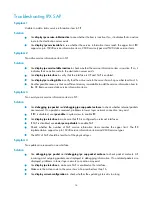
1
Configuring IPX
IPX is a network layer protocol of NetWare that can be used by the HP A-MSR Router Series. Its position in
NetWare is similar to IP’s position in TCP/IP. It implements such functions as address filling, routing and
packet forwarding.
IPX is a connectionless protocol. Though both data and the destination IPX address are included in an IPX
packet, IPX does not confirm whether the packet is forwarded successfully. Such functions as confirmation of
forwarding success and connection control are provided by the protocol at the layer above IPX. Any IPX
packet is considered an independent entity that is not related to any other IPX packets logically or
sequentially.
Address structure
The IPX address structure differs from IP. An IPX address consists of the network address and node address,
in the format: network.node.
Network address
—Identifies the physical network where the site lies. It has a length of 4 bytes,
expressed by an 8-digit hexadecimal.
Node address
—Identifies a node in the network. It has the same structure as MAC address and a length
of 6 bytes. It is entered as three parts of two-byte digits separated by hyphens (
-
) and it cannot be a
broadcast or multicast address.
For example, in the IPX address bc.0-cb-47, the network address is bc (more accurately, it is 000000bc) and
the node address is 0-cb-47 (more accurately, it is 0000-00cb-0047). Therefore, an IPX address can also be
expressed in the form of N.H-H-H, in which N is the network address and H-H-H is the node address.
RIP
IPX employs RIP to maintain and advertise dynamic routing information.
Via RIP, an IPX router exchanges routing information with neighbors and maintains an inter-network routing
information database (usually called "routing table") according to network changes. When the router
receives a packet, it finds a next hop from the routing table to forward the packet.
SAP
SAP is used to advertise the service types that servers provide and their addresses. IPX advertises dynamic
service information through SAP. When a server starts, it broadcasts services it can provide through SAP.
When being shut down, the server informs clients of the termination of services through SAP.
Through SAP, an IPX router creates and maintains an internetwork service information database (usually
called "service information table"). A server on the same network periodically broadcasts its service types
and address. Clients not on the same network as the server cannot get such information directly, which is
collected by the SAP proxy and saved in the server information table in the IPX router for advertisement to
such clients. Because server information is dynamically updated by SAP, clients can always obtain latest
server information.
SAP defines three types of packets, service query, service response, and periodic updates. The following
subsections describe how SAP operates:





































